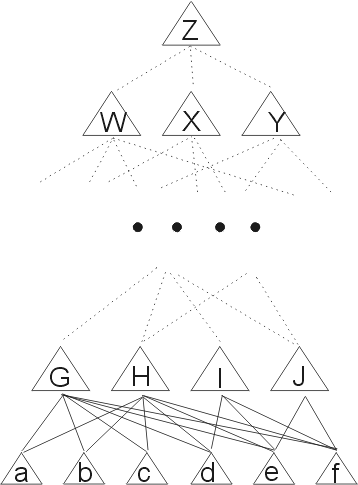Planar Point Location
Edelsbrunner
Kirkpatrick
Subdivision Slabs
Sarnak and Tarjan
Trapezoidal Maps
Randomized Incremental Method
Applet
References & Links
Kirkpatrick's Algorithm
Kirkpatrick (1983) proposed a method for planar point location now known as the triangle refinement method. Given a finite planar sudivision the algorithm creates a corresponding triangular subdivision in which each region is bounded by three line segments (or in simple terms is a triangle)! A polygonal subdivision may be transformed into a triangular subdivision by triangulating each polygon and finally placing a single bounding triangle around the entire region. Note that each triangular region in this new subdivision can be linked to its parent polygon so that a point query which finds a triangle in the triangular subdivision can be used to select the parent polygon.
Given such a triangular subdivision, S a subdivision hierarchy is a sequence of such triangulations creating subdivisions S1, S2, S3, ..., Sh(n) where S1=S and each region R of Si+1 is linked to each region R' of Si where R' intersects R. h(n) is the hieght of the subdivision hierarchy.

Fig. 1: A vertex (in red) is selected and its adjacent regions (labelled a through e) are deleted at the Si level resulting in a new polygonal region (shaded). On the right we see the new triangulation for this polygon at the Si+1 level. New regions in the Si+1 level are then linked to regions in the Si level if they intersect. Thus for example region G would be linked to all regions while region J would be linked to e and f.
The subdivision hierarchy is generated in the following manner. At the lowest level, S1 a set of non-adjacent vertices with degree = 6 are selected. The vertex is deleted resulting in a new polygonal region which replaces the triangles but a degree lower (by 1) than the original region. This new polygonal region is then re-triangulated forming a new set of triangles at the S2 level, which are linked to each of the intersecting deleted triangles from the S1 level. This proceedure is duplicated for all degree 6 vertices at S1 level to generate the S2 level. Then the process is repeated, selecting a new set of degree 6 vertices at the S2 level and repeating the deletion/retriangulation to form the S3 level. The process is repeated until we arrive at the Sh level, which is a the single triangle representing the search region.

Fig. 2: The search structure for a hierarchical subdivision. The lowest levels corresponding to shaded portions of the S1 and S2 levels in Fig. 1 shaded in grey. The Sh level (Z) and the Sh-1 levels are also shown.
With the subdivision hierarchy completed we can now perform queries. The query process operates by starting at the Sh level and working down to the S1 level as follows:
1. Search in the Sh level to determine which triangular region, R, the query point q falls in.
2. Search at the Sh-1 level in all triangular regions linked to R to determine which of these regions q falls in. This region now becomes R and we repeat step 2 at the next lower level until we arrive at S1 at which point we have our result, since the triangular regions in S1 keep a reference to their parent polygon in the original subdivision.
For an excellent discussion of Kirkpatrick's Algorithm see Derek Bradley's project on the topic.